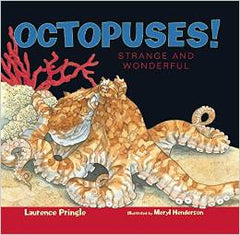Octopuses and other animals April 14 2015, 0 Comments
 There’s a great new book out called Octopuses! Strange and Wonderful. It is by Laurence Pringle and is illustrated by Meryl Henderson. Together they present an attractive, accurate, and informative book about octopuses and other mollusks as well. The book would be an engaging read-aloud for younger elementary children and a good research material for upper elementary. I liked the information about how mollusks’ bodies are structured and how they work. Obviously this author researches his subjects carefully, and he knows how to tell a good story as well.
There’s a great new book out called Octopuses! Strange and Wonderful. It is by Laurence Pringle and is illustrated by Meryl Henderson. Together they present an attractive, accurate, and informative book about octopuses and other mollusks as well. The book would be an engaging read-aloud for younger elementary children and a good research material for upper elementary. I liked the information about how mollusks’ bodies are structured and how they work. Obviously this author researches his subjects carefully, and he knows how to tell a good story as well.
When I looked on Laurence Pringle’s website, I discovered that he has produced many highly rated children’s science books. The Strange and Wonderful series includes books on scorpions, cicadas, alligators and crocodiles, snakes, bats, and sharks. I was familiar with another high quality book by this author, A Dragon in the Sky: The Story of a Green Darner Dragonfly, published in 2001. I’m not sure how I missed the Strange and Wonderful series, but I will certainly seek it out now.
 Another volume I have acquired lately is Animal Earth: The Amazing Diversity of Living Creatures by Ross Piper. It has many uses, from providing gorgeous illustrations of all sorts of animals to giving detailed biology for secondary student research. When I say all sorts of animals, I mean that the book covers all of the 34 phyla currently recognized in the animal kingdom. There is a chapter on animal lineages that helps one understand the current arrangement of those phyla on evolutionary trees (cladograms). The book is structured to follow the cladogram in the contents page. After the first branches of animals, the section on bilaterial animals starts with deuterostomes, and so the chordates, including us, are near the front of the book. Then it covers the protostomes, starting with the molting animals, including arthropods and nematodes. The clade called lophotrochozoa comes next, with annelids, mollusks, flatworms, and rotifers. The order alone will stimulate thought.
Another volume I have acquired lately is Animal Earth: The Amazing Diversity of Living Creatures by Ross Piper. It has many uses, from providing gorgeous illustrations of all sorts of animals to giving detailed biology for secondary student research. When I say all sorts of animals, I mean that the book covers all of the 34 phyla currently recognized in the animal kingdom. There is a chapter on animal lineages that helps one understand the current arrangement of those phyla on evolutionary trees (cladograms). The book is structured to follow the cladogram in the contents page. After the first branches of animals, the section on bilaterial animals starts with deuterostomes, and so the chordates, including us, are near the front of the book. Then it covers the protostomes, starting with the molting animals, including arthropods and nematodes. The clade called lophotrochozoa comes next, with annelids, mollusks, flatworms, and rotifers. The order alone will stimulate thought.
 I found What on Earth?: 100 of Our Planet’s Most Amazing New Species while I was browsing in a bookstore. I highly recommend spending some time going through the stacks at bookstores, particularly those with a science section. I find things there that I missed on Amazon. This little book by Quentin Wheeler and Sara Pennak will likely stimulate conversations and research about a wide range of life. The 100 species are primarily animals, but fungi, plants, and a few protists also appear. There are even two bacteria. A feast for curiosity indeed.
I found What on Earth?: 100 of Our Planet’s Most Amazing New Species while I was browsing in a bookstore. I highly recommend spending some time going through the stacks at bookstores, particularly those with a science section. I find things there that I missed on Amazon. This little book by Quentin Wheeler and Sara Pennak will likely stimulate conversations and research about a wide range of life. The 100 species are primarily animals, but fungi, plants, and a few protists also appear. There are even two bacteria. A feast for curiosity indeed.
